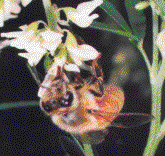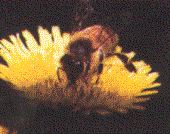

What is a honey bee?

The honey bee is a social insect, and is the only insect that produces food that is consumed by humans. They build their hives above ground, in such places as tree cavities, walls or soffits of buildings, old barrels, or anywhere they can get inside a space of two to three cubic feet. They build extensive comb, made of beeswax(which is produced by the bee itself), in which they raise young, and store pollen and honey. They never build their hives underground.
Unlike wasps, hornets, and yellow jackets, the honey bee colony survives the winter with a large portion of it's population intact. They winter in a tight cluster which allows them to retain most of the warmth they generate. The population of the average honey bee colony ranges from 80-100,000 during June and July to a low of 25-30,000 during late winter.
Honey bee hives have three castes of bees - The queen, workers, and drones. Each hive has only one queen, whose sole purpose is egg laying. The workers are sterile females that do all the work in the hive and gather all the pollen and nectar from trees and flowers during warm weather. The pollen is used to feed the larvae and the nectar is converted into honey and used as food by the adult bees. The drones are male bees which do no work at all in the hive and whose only job is to mate with virgin queens, which is done in the air during the summer. A drone dies as soon as he mates. In the fall, all the drones are dragged out of the hive by the workers and not allowed to return, so they perish. In the spring the hive raises new drones.
During the period of May through June, a hive may become congested with bees and honey, as it's population builds up, and the colony may divide.The old queen and about one-half of the workers and drones will leave. The bees left behind will raise a new queen. The bees that leave will congregate on a tree branch, bush, lamp post, fence post, etc. in what is known as a " swarm ". It is a mass of about 30-40,000 bees in a tight cluster about he size of a soccerball. Although it is a terrifying sight to the uninformed, it is really no threat to anyone if left alone. It fact most of the time you can get quite close to it without any problem. It should never be sprayed with insecticides, water, etc. since this will only antagonize them, and it won't make them leave anyway. They will disperse on their own in a few hours to a few days, as soon as the scout bees have found a new home. If they must be removed, a call to a local beekeeper will quickly solve the problem.
During the summer the bees store tremendous amounts of honey (60-80 pounds in an average hive) which they use as food during the winter. If a hive is killed by pesticides in the wall of a house or similar area, serious problems can result. The bees normally maintain a constant temperature in the hive, but when they are killed the temperature can rise to the point where the honeycomb will begin to soften and melt, allowing the honey to start leaking out. If the the hive is located in the wall of the house, it can cause staining of the walls or ceilings, honey running out of electrical outlets, and the smell of decaying bees, which attract other insects such as ants, beetles, and roaches.
Honey bees are the most beneficial of all insects. They are absolutely necessary as pollinators of trees, flowers, vegetables, and fruits for maximum yield and quality. They are not aggressive and prefer to be left alone to go about their business. They only sting to protect their hive or themselves and are never found around cookouts or picnics like yellow jackets.
